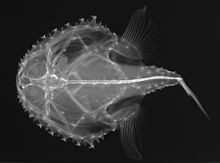
Goosefishes, sometimes called anglers or monkfishes, are a family, the Lophiidae, of marine ray-finned fishes belonging to the order Lophiiformes, the anglerfishes. These fishes are found in all the world's oceans except for the Antarctic Ocean.

Members of the genus Lophius, also sometimes called monkfish, fishing-frogs, frog-fish, and sea-devils, are various species of lophiid anglerfishes found in the Atlantic and Indian Oceans. Lophius is known as the "monk" or "monkfish" to the North Sea and North Atlantic fishermen, a name which also belongs to Squatina squatina, the angelshark, a type of shark. The North European species is Lophius piscatorius, and the Mediterranean species is Lophius budegassa.

Ogcocephalidae is a family of anglerfish specifically adapted for a benthic lifestyle of crawling about on the seafloor. Ogcocephalid anglerfish are sometimes referred to as batfishes, deep-sea batfishes, handfishes, and seabats. They are found in tropical and subtropical oceans worldwide. They are mostly found at depths between 200 and 3,000 m, but have been recorded as deep as 4,000 m (13,000 ft). A few species live in much shallower coastal waters and, exceptionally, may enter river estuaries.

The starry handfish, starry seabat or minipizza batfish, is species of marine ray-finned fish belonging to the family Ogcocephalidae, the deep-sea batfishes or seabats. This fish is found on the continental shelves of the Indo-Pacific oceans at depths of between 50 and 400 m. They are up to 30 cm long.
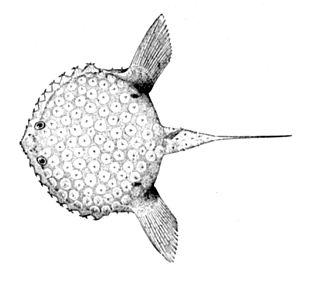
Halieutichthys is a genus of marine ray-finned fishes belonging to the family Ogcocephalidae, the deep-sea batfishes or sea bats. The fishes in this genus are found in the western Atlantic Ocean.
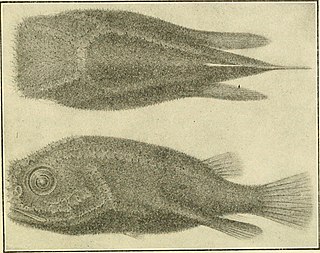
Coelophrys is a genus of marine ray-finned fishes belonging to the family Ogcocephalidae, the deep-sea batfishes or sea bats. The fishes in this genus are found in the western Pacific Ocean and the Indian Ocean.

Dibranchus is a genus of marine ray-finned fishes belonging to the family Ogcocephalidae, the deep sea batfishes. The fishes in this genus are widely distributed in the Atlantic, Indian and Pacific Oceans.

Halicmetus is a genus of marine ray-finned fishes belonging to the family Ogcocephalidae, the deep sea batfishes. The fishes in this genus are widely distributed in the Indian and Western Pacific Oceans.
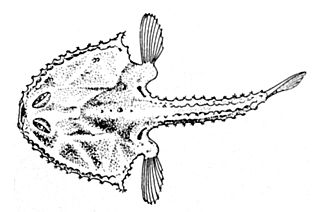
Halieutaea is a genus of marine ray-finned fishes belonging to the family Ogcocephalidae, the deep sea batfishes. These fishes are found in the Indian and Western Pacific Oceans.
The Louisiana pancake batfish, Halieutichthys intermedius, belongs to the batfish family Ogcocephalidae. It is native to the Gulf of Mexico, and was discovered in 2010. The known range of the species lies within the area of the Gulf of Mexico which was affected by the Deepwater Horizon oil spill.

Lophiodes is a genus of marine ray-finned fishes belonging to the family Lophiidae, the goosefishes, monkfishes and anglers. It is one of four extant genera in the family Lophiidae. The fish in this genus are found in the Atlantic, Indian and Pacific Oceans.

Ogcocephalus radiatus or the polka-dot batfish is an arrow-shaped fish in the family Ogcocephalidae with an elongated thin tail. It is dorso-ventrally flattened with round pectoral fins that sit flat on the bottom of the sea floor. It uses its pectoral fins and pelvic fins to "walk" along the bottom in a side-to-side shuffling motion.
Halieutichthys bispinosus, the two-spine batfish or spiny batfish, is a species of marine ray-finned fish belonging to the family Ogcocephalidae, the deep sea batfishes or seabats. This species is found in the Western Atlantic Ocean.

Lophiodes beroe, the white goosefish or white anglerfish, is a species of marine ray-finned fish belonging to the family Lophiidae, the goosefishes, monkfishes or anglers. This species is found in deep waters in the western Atlantic Ocean.
Ogcocephalus porrectus, the rosy-lipped batfish, is endemic to Cocos Island off the Pacific coast of Costa Rica. Though members of Ogcocephalidae occur in tropical, warm waters in both the Western Atlantic and Eastern Pacific. Rosy-lipped batfish generally reside in shallow to deep water benthic zones with a bathymetric range of 35 – 150 m. The syntypic series was collected at 120 m on a rocky bottom. What makes this fish distinctive are its rosy red lips, specialized pectoral fins used for "walking", and an illicium used for attracting prey.

The Atlantic batfish is a species of marine ray-finned fish belonging to the family Ogcocephalidae, the deep-sea batfishes. It is found in deep water in the Atlantic Ocean where it lives on the seabed, feeding on small invertebrates.
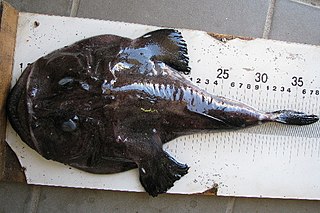
Lophius vomerinus, the devil anglerfish, Cape monk or Cape monkfish, is a species of marine ray-finned fish belonging to the family Lophiidae, the goosefishes, monkfishes or anglerfishes. This species is endemic to the waters of the southeastern Atlantic and southwestern Indian Oceans around Southern Africa.
Dibranchus tremendus is a species of marine ray-finned fish belonging to the family Ogcocephalidae, the deep-sea batfishes. It is found in deep water in the Atlantic Ocean. This species was identified as a different species from Dibranchus atlanticus in 1999. It is the largest species in its genus.

Halieutaea indica, the Indian batfish, Indian handfish or Indian seabat, is a species of marine ray-finned fish belonging to the family Ogcocephalidae, the deep sea batfishes. The Indian batfish has a wide Indo-West Pacific distribution.

The Caribbean batfish, also known as the two-spine batfish, is a species of marine ray-finned fish belonging to the family Ogcocephalidae, the deep sea batfishes or seabats. This species is found in the Western Atlantic Ocean.

